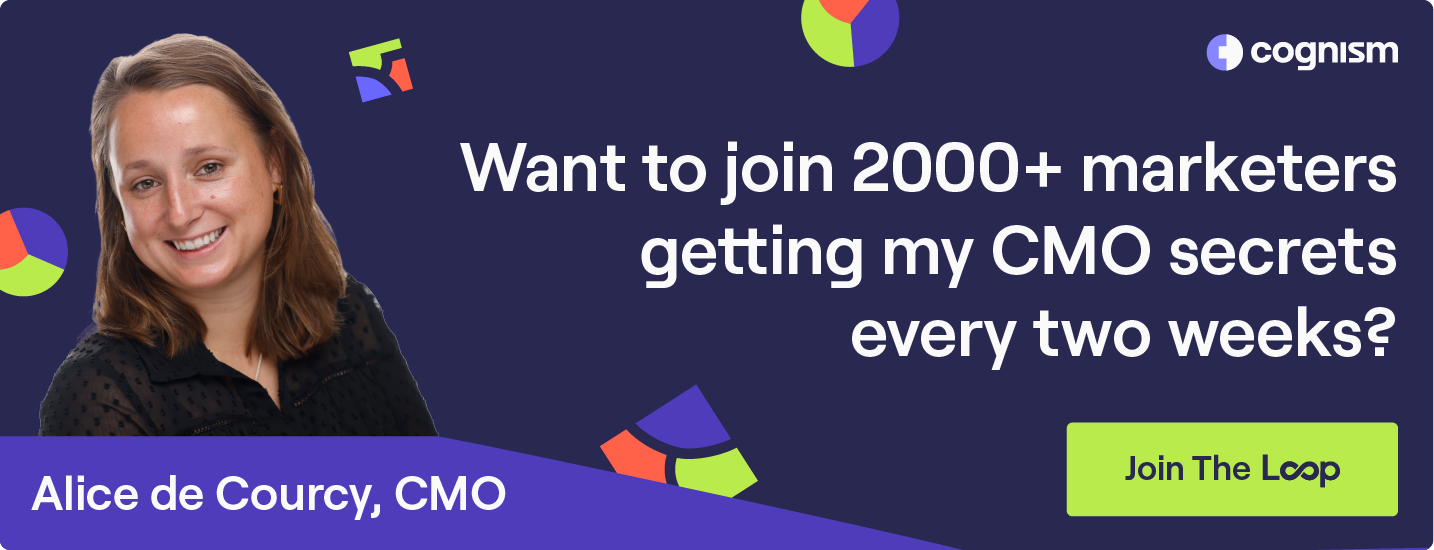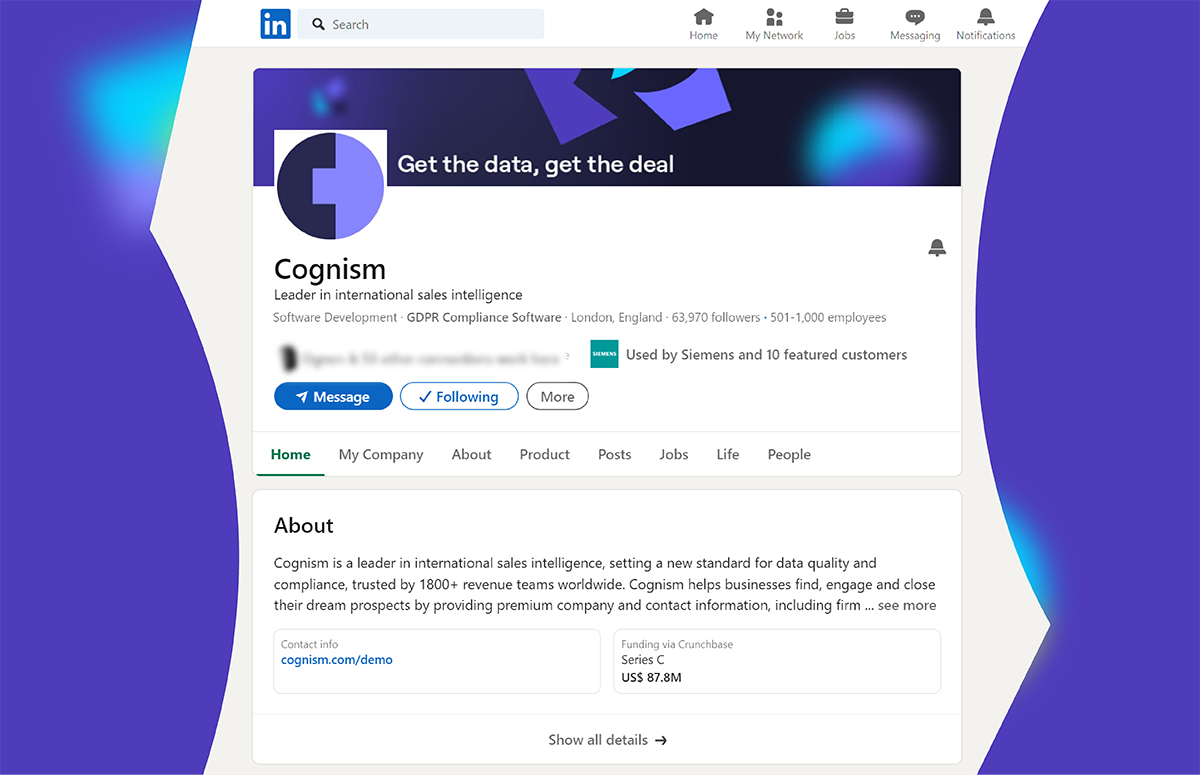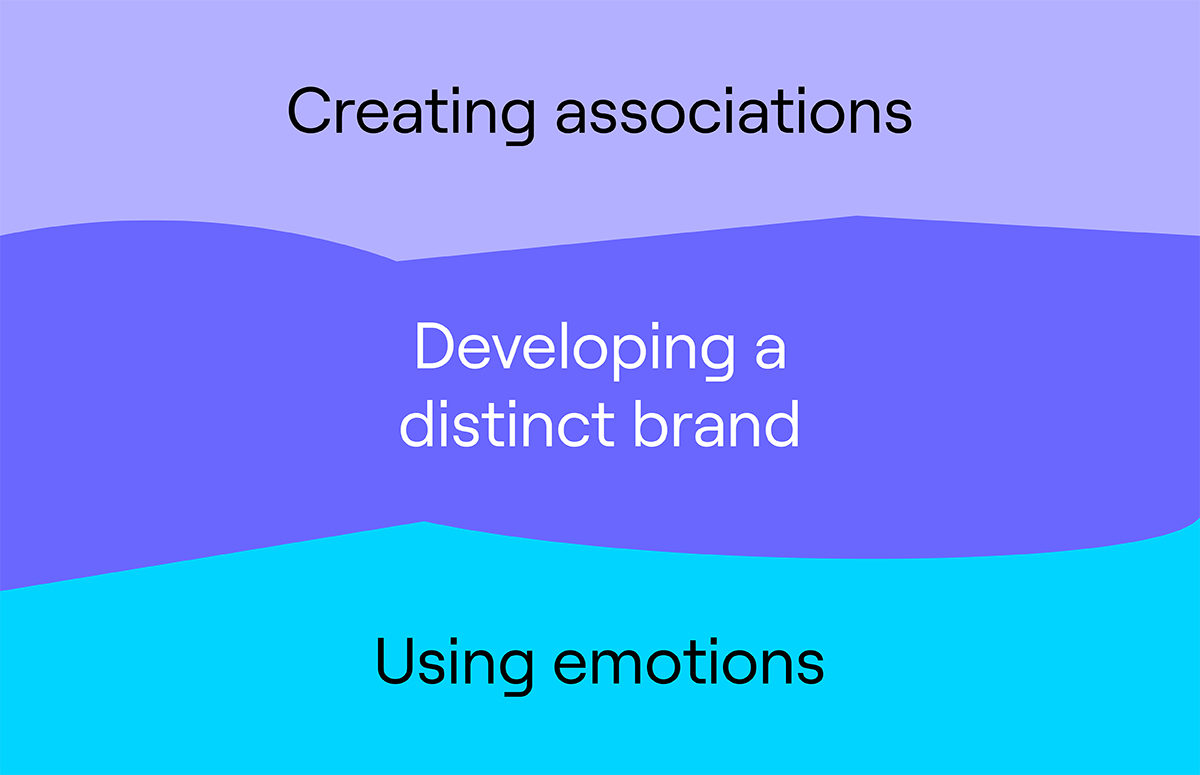How to Produce High-Quality Content Quickly
Content has always been an important part of what we do at Cognism - and this has only intensified since we made the shift to a demand gen approach.
Why?
Because value-led content is a cornerstone of driving demand.
If you master your content strategy, you'll put yourself in the ideal position to:
- Raise awareness of your brand and products.
- Build trust and confidence that you’re an expert in your category.
- Attract prospects inbound.
- Make sales conversations easier.
But not all content is made equal. Especially if you’re trying to publish quality content while it’s fresh and relevant in an already saturated market.
We’ve learned a lot on our content journey, and we still are! So we wanted to share some tips that our content team uses daily. So keep reading!
How we structure our content team
Since the start of Cognism, we’ve had a dedicated, in-house content role. We’ve found this to be critical to our success.
Alice de Courcy, Cognism’s CMO, says:
“The value of having a dedicated content person is immense. It can be such an important lever without spending huge amounts of money.”
“The impact you can make by producing value-led content and building out a strong SEO strategy is huge. I would 100% recommend having a wordsmith in your team.”
As Cognism has grown, so too has the content team.
We have split out the roles into those who focus on driving our SEO strategy and our journalists - who go out to find the story.
This allows us to be reactive to trending topics that our audience is interested in. All without sacrificing valuable traffic that comes from ranking on search engines.
Another key element of our content strategy is that everything we offer is 100% ungated.
We want to showcase the value you get from Cognism upfront - no smoke and mirrors here!
Press play to hear Alice explain how to ungate your content as part of your marketing strategy ⬇️
What do we mean by quality, value-led content?
It’s all well and good telling you to write quality, value-led content, but what the heck does that actually mean?
Well, we’ve set some rules to follow that might help you benchmark.
1. It has to be original
The internet is full of web pages spewing the exact same recycled content. Copying and pasting paragraphs from somewhere else and switching out a few of the words so it’s not picked up as plagiarism.
But that isn’t going to be content that helps you stand out from the crowd or offer any additional value.
Instead, you need to find a way to make your content original and one-of-a-kind. In this vein, it also needs to be credible. You can’t go around making things up to make it original.
This is where Cognism makes use of subject matter experts.
This can include members of our own team. For example, asking Cognism’s SDR onboarding manager how to onboard new team members quickly.
Joe Barron, Cognism’s Senior Content Manager, says:
“You have so much expertise and knowledge internally, so it’s worth making the most of it. Interviewing people within your own company gets you insights into a new subject super quickly.”
Or it could mean external contributors. Such as asking different marketing leaders for insights on how they plan to spend their marketing budget.
Binal Raval, Cognism’s Demand Gen SEO and Content Exec, says:
“LinkedIn means you have access to a lot of outside contacts with the click of a button (and a quick personalised message!) Sometimes, you’ll get ghosted, but just shoot your shot, lots of people are open to having a conversation.”
Interviewing an expert on the chosen topic means you can create an original article filled with specialist insights.
Binal adds:
“Another useful tool you can use is ‘Help a B2B Writer’, or ‘Help a Reporter Out’.”
These websites allow you to submit a request for insights on a certain topic, and people with experience in those subjects can send you a response.
2. It has to contain actionable takeaways
If someone can’t take away an actionable bit of advice from an article they’ve read, then it doesn’t pass the Cognism quality test.
We want to be the place people go to when they’re looking for answers and advice.
This means framing the insights you get from your subject matter experts in a way that’s easy for the reader to lift and apply in their own lives.
3. It has to be engaging
It’s all well and good producing this high-value content - but if it’s dull as dishwater to read, no one is going to.
The goal is to get your readers to read and engage with your content. Otherwise, they’re not going to provide any of the value you’ve spent time curating.
That means:
- Getting your reader hooked from the first sentence. So don’t start with a boring introduction. Instead, tease the value coming in your article.
- Break up the text. Make it easy for your reader to follow. No one likes to stare at lines and lines of text; it’s overwhelming. So split up your paragraphs. Keep your sentences short.
- Don’t forget to include images, videos or infographics. A bonus of adding assets like these is that they can also be beneficial for SEO! You can consider using green screen stock footage that's easily incorporated into your videos. These can be used to create unique, eye-catching visuals to help your content stand out from the crowd.
- Use casual language. There’s been a misconception in B2B marketing that it has to be super formal. But at the end of the day, you’re still talking to a person. Take a leaf out of B2C’s book and use conversational language.
- Tell a story. Bring your reader on a journey. What’s the problem you’re addressing? What’s the context? How can you address it? What are the possible outcomes?
While there’s no real quantifiable measure of which articles are valuable and which aren’t, you can start to get an idea of which your readers engage with.
For example, it’s pretty safe to assume that your reader is getting value from an article when they spend longer on the page.
Hit play below to hear how to build a media machine for B2B in ep. five of Demandism. ▶️
How do we decide what to write about?
Half the battle of producing value-led content is deciding what to write about.
After all, to provide real value for the reader, it needs to be about something that interests them. And something they want to learn more about.
So this means you need to learn as much about your audience as possible and let that lead your title choices.
Binal says:
“If you want to validate if an idea is worth writing about and gauge the interest in it, then you can do a quick LinkedIn poll to ask something about the topic.”
“If it gets a lot of engagement, then it's a sign that it could be a worthwhile topic to pursue.”
Top tip:
This is also great information to include in your article later, e.g. “x number of people said they feel y about z”, linking to your poll as evidence.
Deciding what content to write about might look a little different for our SEO writers than it does for our journalists.
For example, our SEO writers will track metrics from tools like Ahrefs, looking at keywords our audience is searching for.
Daisy Shevlin, SEO and Content Manager at Kaspr says:
“I tend to look for either high intent, low search volume keywords, or higher volume, lower intent keywords and create content using a mix of both.”
“Another tip is to have a look at the search results currently showing for those keywords to see what the highest ranking articles include.”
Whereas our journalists are more likely to be looking at channels such as LinkedIn or other sales and marketing news outlets, finding the latest stories.
Daisy adds:
“For more journalistic style pieces, LinkedIn is a goldmine.”
“Because our ICP is SDRs, just looking at what our own Kaspr or Cognism SDRs are saying is great.”
Not only is LinkedIn great because you can see the topics individuals are posting about, but it also gives you an insight into trending news.
Kate Lismore, Content Editor and Writer at Cognism says:
“Make sure to keep up to date with the ‘LinkedIn News’ on the top right-hand side of your feed; there can be some gems in there and they’re relevant right now.”
Binal says:
“Another place I find trending topics that people are discussing is by looking at marketing and sales podcast episode titles.”
The main message here is that inspiration is everywhere. And it’s all at your fingertips.
But be warned! To find out what people really want to learn about, you need to get involved in conversations happening all around you.
For example, you might have an interview with one subject matter expert, and they mention something else that sparks an idea for another new article. So you have to be listening!
Top tip:
When you have an idea for a new title, write it down. Whether it’s a note on paper or you add it to a task list on a project management tool. It’s amazing how quickly ideas can be lost to the ether when there’s so much going on.
Cognism’s top tips for writing quality content quickly
Every content writer at Cognism has their own way of working. After all, everyone is different!
But we’ve compiled a list of tips from the team that might help you produce more high-quality content in a short timeframe.
1. Plan ahead
By plan ahead, we don’t mean sticking rigidly to a content calendar. In fact, our content writers aren’t bound to a content calendar at all.
We want them to be able to react to trending stories, so they manage their own title output.
Instead, the team focuses on looking at titles they want to write in the coming weeks and booking interviews. This means our writers can be working on writing content, knowing they have a steady stream of insights to inform their next titles.
Binal says:
“I think it’s important not to rush the research phase. So you give yourself a week to collect the right information, then write it the following week. Essentially working in two-week sprints.”
2. Set yourself deadlines
Our authors are autonomous, so they aren’t tied to content deadlines. Unless the content is part of a wider campaign.
So it’s up to them to make sure they’re staying productive.
This is where they’ve found setting soft goals and deadlines for themselves is useful.
Ever heard of Parkinson's Law? It states: ‘work will expand to fill the time allotted for its completion’.
In other words, if you give someone a week to complete a task, they can stretch it out to fill a week’s work. But if you were to give someone three days, they’d (usually) finish the work in three days.
So if you set yourself realistic goals, they can help you stay on track and complete work efficiently.
3. Let your experts lead the content
As we touched on earlier in this blog, we want our content to be full of expert insights. To do this, we interview a subject matter expert and base articles on their expertise.
This means we can’t make any assumptions about the framework, format or contents of the article until we’ve spoken with the experts.
Instead, let the interviews lead your content. They’re the experts, so that’s where the quality content lies. Don’t start writing until you’ve listened to what they have to say.
With this in mind, try to keep your interview questions open-ended to start with. Don’t forget, you can ask more specific follow-up questions once you’ve got their general outlook covered.
Top tip:
Ask your contributors if you can record the interview (just for your own purposes, not to share anywhere!)
This will help you to use active listening and ask better follow-up questions. It’s easier to gather quality information if you’re not worrying about taking notes.
4. Block out time to focus
This is a problem most people face in their jobs - finding time to be productive.
With the number of meetings, admin tasks, SME interviews and more, finding a block of time to zone into an article can be hard.
That’s why we encourage our writers to block out time in their diaries - sometimes full days - to focus on getting their titles done.
Daisy says:
“I’ll block out one-to-two-hour stints every day that I dedicate to writing.”
5. Just get started
Sometimes, the big thing stopping you from writing an article quickly is that daunting feeling of starting a new piece.
There’s nothing scarier in content marketing than a blank page. 😱
Daisy says:
“Sometimes if I’m struggling with how to structure a piece, I just start it."
"Even if I come back to it later and hate everything I’ve written, now I have something to edit which is better than having nothing.”
6. Self edit your work
It’s obvious we know, but don’t forget to check your grammar and spelling! It’s a simple thing, but it makes it much easier for your reader to follow your work.
Tools like spell check or Grammarly can come in handy here!
Kate suggests another useful tool to use once you’ve finished your article.
“The best advice I can give is to remove unnecessary words. That’s where tools like Hemingway can be handy.”
Hemingway App grades your articles based on how easy they are to read. It also highlights areas for improvement.
Another great tip from Kate is to use an active voice; she says:
“Again, Hemingway can help to show you where you’re using too many passive words.”
Kate adds:
“Also, be careful to keep a consistent verb tense throughout.”
Top tip:
Read your article out loud to yourself. If you stumble over words, then it’s likely overcomplicated and hard to read, so spend some time finessing.
Another great tip is to proofread your article the day after finishing it. Fresh eyes can pick up on mistakes that they couldn’t spot the day before!
Review your content metrics
Writing content shouldn’t be a set-it-and-forget-it exercise (especially in SEO!!)
You can learn a lot from data; its insights help to inform your future content. As well as ways to update and improve past content.
Again, the metrics you care about might differ when the goals are SEO-based versus journalistic content.
For example, content intended to rank on Google - unsurprisingly, the main thing you’re going to be interested in is whether it ranks well.
Then you’ll be more interested in page views and traffic value.
Whereas journalistic style content - while it’s great if it does rank on Google - is not necessarily designed to.
In this case, you’ll be interested in looking at metrics such as:
- Average time spent on page
- Page views
- Average page scroll depth
- CPI score (SmartOcto: engagement, exposure and loyalty)
These give you insights into what content is attracting attention and what isn’t. This helps to feed into your future decisions for what content to focus on. It will also highlight what isn’t worth the time investment.
Content that’s performing well could also be ripe for the picking when it comes to repurposing. For example, you may take short snippets of your top-performing articles to use on social channels.
And don’t worry, we’ll be back with a second article about how to repurpose your content - so keep your eyes peeled!



